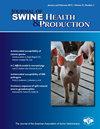Development of effective and minimally invasive surgical techniques for the preparation of intact, sterile boars
IF 0.7
4区 农林科学
Q3 Agricultural and Biological Sciences
引用次数: 1
Abstract
Objective: The objective of this study was to evaluate three surgical procedures to produce intact, sterile boars. Materials and methods: Boars (n = 39) were allocated to one of four treatment groups: no surgery (control), epididymectomy by removal of the epididymis tail (TE), vasectomy via scrotal access (VS), and vasectomy via inguinal access (VI) at 63 days of age. Selected physiological, hematological, and endocrine responses were monitored after surgeries to evaluate the different techniques’ relative safety and effectiveness. Results: Libido and testosterone concentrations were not affected by surgical treatment and were similar to those observed in the control group. The TE and VS procedures required the least and most time to complete, respectively, while VI was intermediate (P < .001). Both lactate and cortisol concentrations were elevated at the time of surgery compared with the control group, but had decreased by 2 days post surgery (P = .02). Implications: Considering the surgical time and ease, the TE procedure is suggested as the choice technique for producing intact, sterile boars. The swine industry is shifting from individual crates to the use of group pen housing of sows. Use of intact, sterile boars could be implemented to improve estrus detection in group pen housing systems.开发有效的微创手术技术,以制备完整、无菌的公猪
目的:本研究的目的是评估三种外科手术方法来生产完整的、无菌的公猪。材料与方法:选用39头63日龄公猪,分为不手术组(对照组)、切除附睾尾(TE)、经阴囊输精管结扎组(VS)和经腹股沟输精管结扎组(VI)。术后监测选定的生理、血液学和内分泌反应,以评估不同技术的相对安全性和有效性。结果:手术治疗不影响患者的性欲和睾酮浓度,且与对照组相似。TE和VS分别需要最少和最多的时间来完成,而VI是中间的(P < .001)。与对照组相比,手术时乳酸和皮质醇浓度均升高,但术后2天下降(P = 0.02)。意义:考虑到手术时间和容易,建议TE手术作为生产完整、无菌公猪的选择技术。养猪业正在从单个猪栏转向使用母猪的集体猪栏。使用完整的、无菌的公猪可以提高群围栏系统的发情检测。
本文章由计算机程序翻译,如有差异,请以英文原文为准。
求助全文
约1分钟内获得全文
求助全文
来源期刊
CiteScore
1.80
自引率
0.00%
发文量
29
审稿时长
>36 weeks
期刊介绍:
The Journal of Swine Health & Production (JSHAP) is an open-access and peer-reviewed journal published by the American Association of Swine Veterinarians (AASV) since 1993. The aim of the journal is the timely publication of peer-reviewed papers with a scope that encompasses the many domains of applied swine health and production, including the diagnosis, treatment, management, prevention and eradication of swine diseases, welfare & behavior, nutrition, public health, epidemiology, food safety, biosecurity, pharmaceuticals, antimicrobial use and resistance, reproduction, growth, systems flow, economics, and facility design. The journal provides a platform for researchers, veterinary practitioners, academics, and students to share their work with an international audience. The journal publishes information that contains an applied and practical focus and presents scientific information that is accessible to the busy veterinary practitioner as well as to the research and academic community. Hence, manuscripts with an applied focus are considered for publication, and the journal publishes original research, brief communications, case reports/series, literature reviews, commentaries, diagnostic notes, production tools, and practice tips. All manuscripts submitted to the Journal of Swine Health & Production are peer-reviewed.

 求助内容:
求助内容: 应助结果提醒方式:
应助结果提醒方式:


